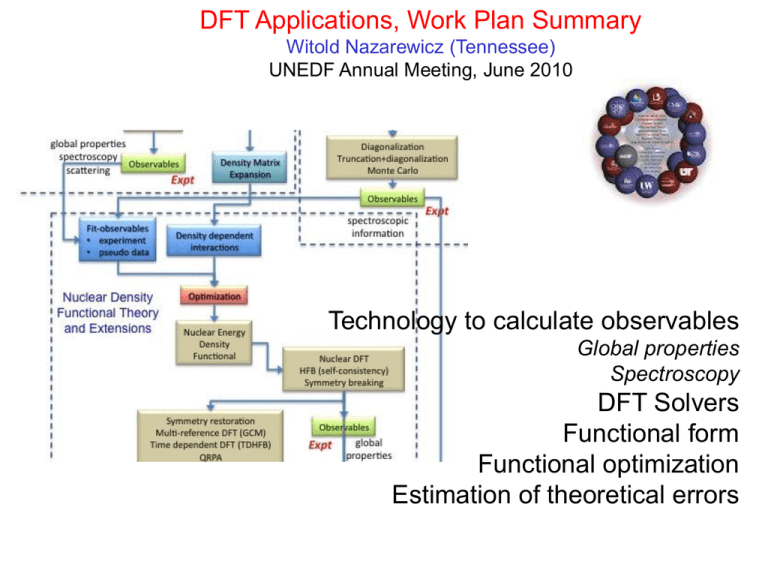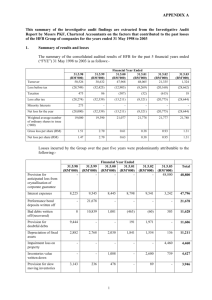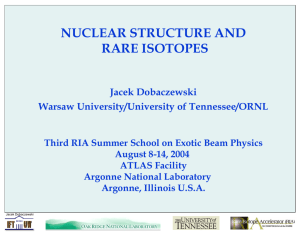DFT Applications
advertisement

DFT Applications, Work Plan Summary Witold Nazarewicz (Tennessee) UNEDF Annual Meeting, June 2010 Technology to calculate observables Global properties Spectroscopy DFT Solvers Functional form Functional optimization Estimation of theoretical errors Year-4 Accomplishments •Optimization algorithms POUNDER and POUNDERS •UNEDFpre EDF optimization (first ever on deformed HFB level, including sensitivity analysis) •Benchmarking of 3D MADNESS-HFB Nuclear DFT solver •SLDA and ASLDA benchmark. Tests up to 100 particles in deformed trap. Improved parallel scaling •Benchmarking of 3D SLDA solver •HFRAD and SLDA benchmark. Wave functions stored on many processors. Ready to run •Performance optimization of oscillator-expansion DFT solvers •HFBTHO calibration and optimization, making use of many cores •HFODD developments: loop-reordering; multi-threading gives significant speed-up; ScaLAPACK implemented: very large bases (Nshell > 25) can now be used •EDF for asymmetric unitary gas •Prediction of the Larkin-Ovchinnikov phase in extremely elongated traps •Different deformability of SLDA and SLDA •Optimized HFODD •Isospin mixing •Augmented Lagrangian Method for constrained calculations •Full Optimized Effective Potential solution in 1D (KümmelPerdew algorithm) implemented and tested against HF. OEP HFB equations derived •Naturalness of energy density functionals tested •Studies of theoretical uncertainties. Developing tools to assess importance of new observables •Test of the Negele–Vautherin density-matrix expansion (with the Gogny force) arXiv:1005.5145 ALSDA 3D solver benchmarked and ready to run Parallelization of HFODD HFBTHO multicore scaling Threading (OpenMP) Time of 10 HFB iterations as function of the number of threads (Jaguar Cray XT5 – Skyrme SLy4, 152Dy, HFB, 14 full shells) HFBAX-applications arXiv:1005.3239 Augmented Lagrangian Method for Constrained Nuclear Density Functional Theory arXiv:1006.4137 Natural Units For Nuclear Energy Density Functional Theory Publications Large-Scale Surveys •One-quasiparticle States in the Nuclear Energy Density Functional Theory," N. Schunck, J. Dobaczewski, J. McDonnell, J. More,, W. Nazarewicz, J. Sarich, and M.V. Stoitsov, Phys. Rev. C 81, 024316 (2010). Development/Algorithms •"Nuclear Energy Density Optimization," M. Kortelainen, T. Lesinski, J. More, W. Nazarewicz, J. Sarich, N. Schunck, M. V. Stoitsov, and S. Wild, arXiv:1005.5145. •“Augmented Lagrangian Method for Constrained Nuclear Density Functional Theory," A. Staszczak, M.Stoitsov, A. Baran, and W. Nazarewicz, arXiv:1006.4137. •"Fast Multiresolution Methods for Density Functional Theory in Nuclear Physics," G. I. Fann, J. Pei, R. J. Harrison, J. Jia, J. Hill, M. Ou, W. Nazarewicz, W. A. Shelton, and N. Schunck, Journal of Physics: Conference Series 180, 012080 (2009). Concepts/Applications •"Self-consistent symmetries in the proton-neutron Hartree-Fock-Bogoliubov approach," S. G. Rohoziński, J. Dobaczewski, and W. Nazarewicz, Phys. Rev. C 81, 014313 (2010). •"Spatial symmetries of the local densities," S.G. Rohozinski, J. Dobaczewski, and W. Nazarewicz, IJMPE 19, 640 (2010) •"Isospin-symmetry restoration within the nuclear density functional theory: Formalism and applications," W. Satula, J. Dobaczewski, W. Nazarewicz, M. Rafalski, Phys. Rev. C 81, 054310 (2010). •“The information content of a new observable: the case of the nuclear neutron skin," P.–G.Reinhard and W. Nazarewicz, Phys. Rev. C 81, 051303 (2010). •“Nuclear halo structure and pseudospin symmetry," W. Long, P. Ring, J. Meng, N. Van Giai, and C. A. Bertulani, Phys. Rev. C 81, 031302 (2010). •"The Negele–Vautherin density-matrix expansion applied to the Gogny force," J. Dobaczewski, B.G. Carlsson, and M. Kortelainen, J. Phys. G 37, 075106 (2010). •“Competition between Normal Superfluidity and Larkin-Ovchinnikov Phases of Polarized Fermi Gases in Elongated Traps”, J. C. Pei, J. Dukelsky and W. Nazarewicz, arXiv:1005.3239 •“Natural Units For Nuclear Energy Density Functional Theory”, M. Kortelainen, R. J. Furnstahl, W. Nazarewicz and M. V. Stoitsov arXiv:1005.2552 Year-4 Deliverables Develop Skyrme-DFT multiwavelet HFB code based on MADNESS, optimized for petaflop boxes. Implement outgoing boundary conditions for interior and exterior scattering problems in 3D SLDA and ASLDA benchmarking has been done. Tests have been run up to 100 particles in deformed trap. Improved parallel scaling. Multiresolution Skyrme-HFB solver with box boundary condition, for a system with a few hundreds of nucleons well on target. Scattering problem moved to Year-5 Profile ASLDA DFT solver with pairing The 3D solver ready to run. Benchmarked against HFBRAD for spherical systems. Connection to TD code developed Optimize generalized Skyrme functional containing novel long-range terms from DME using the MFQns algorithm and "Golden Data Standard". First applications of UNEDF-1 UNEDFpre developed. Methodology tested and ready for further developments. Complete first version of parallel HFODD code; improve parallel interface to HFODD By loop-reordering, multi-threading significant speed-up achieved; ScaLAPACK implemented: very large bases (Nshell > 25) can now be used. A parallel interface is fully in place, which allows to do (for example) large-scale multiconstrained calculations. (Some features of HFODD, mostly related to I/O, have to be disabled to really scale to 50k processors.) Implement the Augmented Lagrangian Method for fission calculations in multidimensional collective spaces Submitted for publication Plan for Rest of Year-4 • Optimization • Open-source implementation of model-based algorithms • POUNDERS applications (UNEDF-0, UNEDF-1 functionals including date on single-particle levels, superdeformations, and neutron droplets • Multiresolution 3D HFB developments • Multiresolution ALSDA solver for 1K+ particles. The bottle-neck is the diagonalization step. SCALAPACK to be worked out (integer*8 interface issue). • Multiresolution Skyrme-HFB solver with box boundary condition finished. • HFODD developments • More OpenMP, debugging of ScaLAPACK routine • First tests of ADIOS library (at scale) • First development of a prototype python visualization interface • Tests of large-scale, I/O-briddled, multi-constrained calculations • ALSDA developments • Profile current code and investigate stability of results with respect to pairing window • Parallelization of the code + proton-neutron extension Plan for Year-5 •Performance, evaluation, and validation of non-standard functionals UNEDF-n based on DME •Applications of UNEDF-n (surveys, fission, etc.) •Development of algorithms for noisy and constrained calculations; many core optimizations •Multiresolution 3D HFB: Calculation of extremely large systems; fission; implement of out-going boundary condition •HFODD developments: Full implementation of ADIOS; set up framework for automatic restart (at scale) •Optimized Effective Potential developments: 3D-HFB; compare with HF, HF-DME, ab initio






![The Politics of Protest [week 3]](http://s2.studylib.net/store/data/005229111_1-9491ac8e8d24cc184a2c9020ba192c97-300x300.png)




